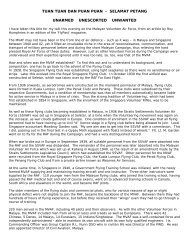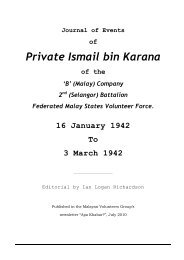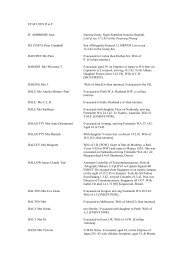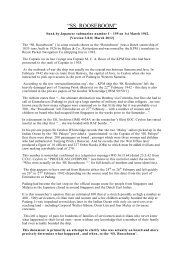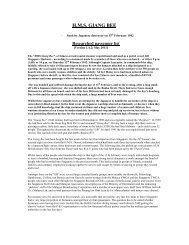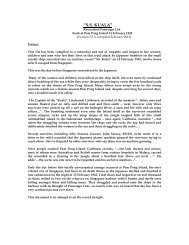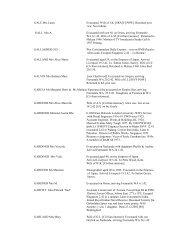PalembangMuntok report.pdf - Malayan Volunteers Group
PalembangMuntok report.pdf - Malayan Volunteers Group
PalembangMuntok report.pdf - Malayan Volunteers Group
You also want an ePaper? Increase the reach of your titles
YUMPU automatically turns print PDFs into web optimized ePapers that Google loves.
MVG Australia member Judy Balcombe, whose grandfather Colin Campbell died in captivity<br />
at Muntok [today Mentok] visited Indonesia in April 2011 with<br />
Anthony Pratt whose father Donald also died in captivity there. Judy <strong>report</strong>s:<br />
We had a very interesting and productive trip to Palembang and Bangka Island. We flew to Palembang from<br />
Singapore. Palembang is a busy city with a lot of cars and motor bikes and a scarcity of traffic lights, making it<br />
quite hazardous to cross the road. We were very lucky to meet with a guide from the Sultan Mahmud<br />
Badaruddin Museum, near the Kuto Besak fort on the Moesi River. He took us to view the Palembang jail<br />
where the male internees spent their first year. It is still in use, a great high-walled and grim building.<br />
We next visited the Indonesian Independence memorial. In the grounds there was a large relief mural,<br />
showing the privations of the internees under the Japanese.
Our guide helped us to buy a large-scale city map of Palembang. We were able to compare the streetscape<br />
with maps from the East Indies Camp Archives website and from this, were able to pinpoint the locations of<br />
the Boekit Besar camp, Irenelaan Women's camp and the Men's Atap Barrack camp. For readers who are<br />
familiar with the internee William McDougall's books, 'Six Bells off Java Head' and 'By Eastern Windows' as well<br />
as the writings of internee Helen Colijn and the Australian nurses, many landmarks were familiar, leading to a<br />
sobering walk through the suburbs.<br />
We were able to see the road where the men would have walked on the working camp from the jail to the site<br />
where they built their next camp, the Men's Barrack camp. The route took them past the Women's camp and<br />
some women would stand on the camp wall, calling out and waving to their husbands, fathers and sons as they<br />
passed by. We recalled one Christmas when the women were quiet as the men approached, then began to<br />
sing English and Dutch Christmas carols. The Japanese guards let the men stop and listen for a while before<br />
ordering them on to work.<br />
We also visited the Charitas hospital in Palembang, now a large and modern hospital. This is where some<br />
internees were allowed to be treated in the early days of the camps. At times and with great risk and coordination,<br />
it was possible for husbands and wives each to be admitted to hospital at the same time and meet<br />
for a few minutes, although such meetings were rare. Nuns and some internees took a great risks in smuggling<br />
letters and medicines from the hospital back into camp - sometimes these notes were the only way husbands<br />
and wives could know knew each other was alive.<br />
The Japanese closed the hospital quite early. There is a grassy knoll in the hospital grounds that the Japanese<br />
used as a lookout and a fort.<br />
We were able to travel downstream on the Moesi river in a small wooden boat to view the oil refineries of<br />
Pladjoe. These were a major cause of the Battle of Palembang, with the Japanese fighting for control of<br />
Sumatran oil.<br />
Communication with Singapore had been interrupted in February 1942 meaning that vessels which evacuated<br />
just before the Fall of Singapore did not know the Japanese had taken Sumatra. There were many Japanese<br />
planes and boats in and around the Bangka Straits, leading to the bombing and sinking of many evacuating<br />
vessels. It is estimated that about 5000 evacuees from Singapore lost their lives between 13th to 17th<br />
February 1942.
We caught a jetfoil boat from Palembang to Muntok (which is now known as Mentok). The journey took 3<br />
hours - 2 hours on the Moesi River and an hour on the sea to Bangka Island. The trip with a VIP was<br />
comfortable, air-conditioned with a wash-room, refreshments and even TV - certainly a far cry from the trips<br />
endured by the internees as they were moved backwards and forwards from Bangka Island, often with no<br />
water and with a journey lasting between 12 and 26 hours.<br />
I think we were apprehensive about visiting the island where our families died in such sad circumstances but<br />
surprisingly were left with some very positive images. We were met at the ferry by a friend of our host and<br />
were taken to a beach where the town was engaged in a mangrove - planting community day.<br />
We spent 3 days on the island and met with exceptional friendliness and kindness as well as interest in our<br />
quest every minute of each day.
The main reason for our visit was to see if we could establish where our relatives had been buried after dying<br />
in the Muntok jail in 1944 and 1945 and to learn what had become of their graves. Both Anthony Pratt and I<br />
and several other people have in our possession a photograph of our relatives' graves, marked with a cross and<br />
very neatly and regularly presented. These photos came into our families' possession about 1948 and we<br />
believe the Dutch prepared the graves after the war and also offered photos to relatives.<br />
It had been suggested by the Commonwealth War Graves Commission that civilian graves from Muntok had<br />
been moved to the War Cemetery in Bandung, Java in the early 1960s. The Dutch War Graves Foundation,<br />
however wrote to us that whereas the Dutch Military and civilian graves and the British Military graves had<br />
been moved to Bandung, they believed the British civilian graves had been left behind in Muntok. The DWGF<br />
visited Muntok in the 1980s and found the grave area had been covered over by a petrol station and housing,<br />
built in the 1980s..<br />
This view that the graves had not been moved to Java in the early 1960s was upheld by correspondence we<br />
had seen between Shelagh Lea (nee Brown) and the Commonwealth War Graves Commission, now held in the<br />
National Archives in Kew. Shelagh Brown had been interned in the Palembang, Muntok and Belalau camps and<br />
her mother had died in Muntok Women's camp. Shelagh wrote to the Commonwealth War Graves<br />
Commission for over 20 years, requesting that the cemetery at Muntok be maintained, or at least, as it<br />
deteriorated, that a permanent memorial be placed there. The replies from CWGC initially sounded hopeful<br />
that the graves may be preserved but concluded in 1967 and 1968 by saying that the CWGC had 'no<br />
responsibility for civilian graves' and would not be contributing financially to their care. It was suggested to<br />
Shelagh Lea that she try to raise funds herself or through local churches to pay for a memorial at Muntok.<br />
We were taken to the Pertamina Petrol station, situated on the main road through Muntok, which is how the<br />
cemetery location was described in Shelagh Lea's letters. The petrol station is next to an existing local<br />
cemetery - it is described in Shelagh Lea's letters that the civilian cemetery was down a short path from the<br />
local cemetery. Local residents in houses surrounding the petrol station showed us some much older graves in<br />
their garden area, one for Isabella Inkster who died at sea in 1881.<br />
A resident told us he had played in the previous cemetery when he was a child in the early 1960s and showed<br />
us where the boundary walls had been. He agreed that the graves had appeared as in our photographs and<br />
indeed the Heritage Community had a photograph of matching graves, taken by one resident's father. The man
who had played in the cemetery described seeing some graves exhumed in the early 1960s, being placed in<br />
bags with metal name plates - certainly a military-sounding exercise and not the care that was declined to<br />
British civilians by the CWGC!<br />
From the old cemetery site, we visited a Catholic Cemetery at Kampong Menjelang nearby. Here there was a<br />
grave with an engraved headstone which translated to read that 'Herein lie the remains of 25 English people<br />
who died at the hands of the Japanese between 1942 and 1945, buried here in March 1981'. We were told<br />
these remains had been recovered during the building of the Pertamina petrol station, adding further weight<br />
to our conviction that the remains were never moved to Java. A house is soon to be built on the vacant land<br />
behind the petrol station and it will be interesting to learn if any remains are found there.
In Muntok, we visited the jail which is still in use. Although the care of the prisoners now is good, the physical<br />
description by William McDougall, telling of high walls and dormitories with concrete sleeping slabs could still<br />
be recognised. The jail has the capacity for 250 men - it was hard to envisage over 700 internees inside. It was<br />
from here that the burial parties would carry the dead to the cemetery, wth up to 4 deaths daily during the<br />
later months of 1944 and early1945.<br />
We visited the site of the Women's camp, now a playing field and with only the well left to tell of the 100's of<br />
women who lived and died in cramped atap huts. Here we were introduced to an older lady who still has in her<br />
possession a ring given to her father in return for food given to a lady internee and her children.
A portion of stone used as part of the Women's camp kitchen and latrines was used to create the memorial to<br />
the Australian Nurses who drowned after the sinking of their ship, the Vyner Brooke and those who were shot<br />
by the Japanese on the beach on February 14th 1942. After trying to surrender, two groups of men were<br />
bayoneted and shot and then 22 nurses and a civilian woman were marched into the sea and shot. Vivian<br />
Bullwinkel was the only survivor of the nurses - although shot, she lay in the sea until the Japanese left and<br />
was able to hide in the jungle for 12 days, caring for an injured soldier, Kingsley. They received food from<br />
villagers but surrendered as Kingsley's condition worsened. The Australian nurses already captured swore not<br />
to discuss Vivian's experiences, to protect her execution by the Japanese.<br />
The nurses' memorial was built in 1992 and Nurse Vivian Bullwinkel was present, wearing her same uniform<br />
with the bullet holes.<br />
We were taken to the site of the massacres, accessible by boat and met a man whose Father had helped Vivian<br />
Bullwinkel and Kingsley. The place is still known as 'English Bay and the locals refused to eat fish from this area<br />
for some time after the killings. It was hard to know that such a peaceful and lovely bay had been the site of<br />
such atrocities.<br />
We were also introduced to other older residents who had experienced the war years - a lady of mixed Dutch-<br />
Indonesian parentage who had to dye her hair black as a teenager to avoid being assault by the Japanese;<br />
another lady who now lives in a house which had been commandeered by the Japanese as their<br />
headquarters and a man who lived in Muntok as a boy. He observed that the Japanese officers were often<br />
well-educated, having been educated in England or America, and were more civil and with better ethics than<br />
the regular soldiers and guards.<br />
There were many impressions and new information gained in Muntok through the help of our kind and very<br />
helpful local friends. One very unexpected benefit comes in the fact that the local Heritage Community is in<br />
the process of creating a museum in the old Tinwinning building, opposite the jail.
The Tinwinning Building<br />
This will cover the history of Bangka Island and include the war years. We have asked the Community if it will<br />
be possible to place a plaque to remember our families who died in the jail - it will be heartening to know that<br />
visitors may know what happened in this place.<br />
The local people are sincerely interested in the events of the past and I would like to ask if any members of the<br />
<strong>Malayan</strong> Volunteer <strong>Group</strong> may have items which they would like to donate or to have photographed for the<br />
museum or any memories to share to help with the planned exhibits. I am sure the museum will be a place<br />
where the events of the past and especially the war years will be treated with great honour and respect.<br />
See MENTOK 2011 website at http://mentok.posterous.com/ for more information about the Tinwinning<br />
Building.



